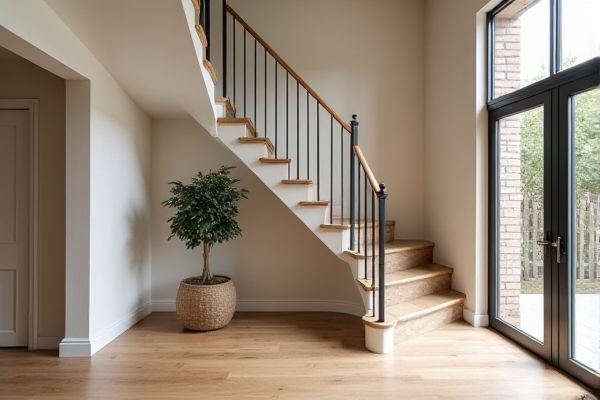
A duplex staircase offers enhanced space efficiency and architectural appeal compared to a single staircase, which typically occupies more floor area and may lack design versatility. Explore the detailed comparisons ahead to determine which staircase best fits Your home's style and functionality.
Table of Comparison
| Feature | Duplex Staircase | Single Staircase |
|---|---|---|
| Design | Two staircases, often connected between floors | One continuous staircase |
| Space Efficiency | Requires more space due to dual structures | More compact footprint |
| Cost | Higher construction and material costs | Lower overall cost |
| Functionality | Supports multi-level access and traffic flow | Suitable for simple floor-to-floor connectivity |
| Aesthetics | Offers modern, luxurious appeal | Traditional and straightforward look |
| Safety | Potentially safer with multiple exit points | Limited escape routes |
| Maintenance | More complex and costly upkeep | Easy to maintain |
Introduction to Duplex and Single Staircases
Duplex staircases feature two flights connected by a landing, maximizing vertical space in multi-level homes, while single staircases consist of a straightforward, continuous flight ideal for smaller areas. The duplex design offers enhanced architectural appeal and improved traffic flow between floors, contrasting with the single staircase's simplicity and cost-effectiveness. Selecting between these depends on spatial constraints, aesthetic preferences, and functional needs in residential or commercial buildings.
Key Differences Between Duplex and Single Staircases
Duplex staircases feature two flights connected by an intermediate landing, maximizing space utilization and enhancing architectural appeal, while single staircases consist of a straightforward, continuous flight without landings. Duplex designs offer improved safety and comfort by breaking the climb into manageable sections, whereas single staircases often occupy less horizontal space but can be steeper and harder to navigate. Material choices and structural complexity differ, with duplex staircases requiring more robust support due to their segmented layout compared to the simpler construction of single staircases.
Structural Design of Duplex Staircases
Duplex staircases require a more complex structural design compared to single staircases, involving reinforced load-bearing elements to support multiple floors and increased traffic flow. The design typically includes intermediate landings and robust stringers to ensure stability and safety. Engineered materials and precise calculations for load distribution are essential to accommodate the extended height and dynamic forces unique to duplex structures.
Structural Design of Single Staircases
The structural design of single staircases centers on straightforward load distribution, typically requiring fewer support elements such as stringers and beams. Single staircases often follow a linear or slightly curved path, allowing for simpler framing and minimal impact on the overall building structure. You can optimize space and materials by selecting single staircase designs that align with your architectural requirements and structural constraints.
Space Utilization Comparison
A duplex staircase maximizes vertical space by connecting two floors within a compact footprint, ideal for smaller homes or apartments where conserving square footage is crucial. Single staircases, while simpler, require more horizontal space and can limit efficient room layouts in tight areas. Choosing a duplex design enhances space utilization by integrating stair access seamlessly into multi-level living without sacrificing valuable floor area.
Aesthetic Considerations
Duplex staircases offer a striking visual appeal with their open, spacious design that enhances natural light flow and creates a luxurious focal point in modern homes. Single staircases often present a more traditional and compact aesthetic, fitting seamlessly into various architectural styles without dominating the space. Choosing between the two depends on balancing the desire for grandeur and openness with space efficiency and stylistic harmony.
Cost Implications and Budgeting
Duplex staircases generally involve higher construction and design costs due to their complexity and use of premium materials compared to single staircases. Single staircases are more budget-friendly, requiring less space and simpler engineering, making them suitable for tighter budgets. Your budgeting should consider long-term maintenance expenses, as duplex staircases often need specialized upkeep, impacting overall cost efficiency.
Safety and Accessibility Factors
Duplex staircases offer enhanced safety with separate entry and exit routes, reducing congestion and improving emergency evacuation efficiency compared to single staircases. Accessibility is improved in duplex designs through wider steps and dual access points, accommodating residents with mobility challenges more effectively. Single staircases often pose higher risks due to limited space and potential bottlenecks, impacting overall safety and ease of movement.
Suitability for Different Building Types
Duplex staircases are ideal for multi-level residential buildings and commercial spaces requiring separate access between floors, offering enhanced space utilization and aesthetic appeal. Single staircases suit simpler architectural designs, such as small homes or offices, where space is limited and straightforward vertical movement is sufficient. Choosing between duplex and single staircases depends on building size, floor count, and functional requirements.
Choosing the Right Staircase for Your Project
A duplex staircase offers space efficiency and aesthetic appeal by connecting two levels with a compact, often L-shaped or U-shaped design, ideal for multi-story homes or offices with limited floor area. A single staircase provides a straightforward, linear ascent, suitable for open floor plans or projects prioritizing simplicity and cost-effectiveness. Choosing the right staircase depends on your project's spatial constraints, design preferences, and functional needs to ensure optimal flow and safety.
 homyna.com
homyna.com